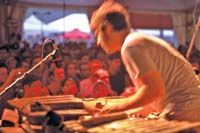
There is no better place to start than Toronto, when searching for the true spirit of Canada.
The city’s name derives from the Huron First Nation’s word for meeting place, and the unique Museum of Inuit Art also underlines the native Americanism of this northern land.
Only Canadians could create a city, which despite freezing temperatures bills itself as an attractive destination in the winter by having shopping centres underground in the PATH below city complex featuring 27 kilometres of walkways and 1,200 shops, services and entertainment outlets.
Only Canadians, even with the USA as neighbour could boast of the world’s longest street, Yonge Street, the tallest building, CN Tower, soon to be superseded by the Burj Dubai, and the Niagara Falls. They are truly awesome and more spectacular, when viewed from the Canadian side, than from the USA.
And only a city as large as Toronto could highlight its rich cultural environment with no less than 200 professional theatre and dance companies. Plus a year round calendar of festival events from April’s Green Living Show to May’s Four Winds Kite Festival and June’s quirky Woofstock Festival for dogs.
July features jazz and musical festivals, August celebrates the Buskers and September displays the famous Toronto International Film Festival. October sees the world’s largest creative sewing and needlework event plus Halloween celebrations on Main Street.
No matter which section you decide to explore, the city has such a cosmopolitan atmosphere it cannot help but inspire all visitors.
Although Toronto is a city with two million inhabitants, it is in fact a metropolis made up of many different villages representing no less than 100 cultures.
There is Yorkville with its university students chattering on mobile phones with laptops on their knees. A stroll into Chinatown puts the visitor face to face with jade, bamboo and silk treasures or you can find yourself in Little India with the biggest South Asian marketplace outside the subcontinent.
Or if you fancy listening to the sound of the bouzouki, try Greektown on Danforth or you can also explore Little Italy and cappuccinos served in the cafes. European cultures and cuisine can be located in the Bloor West Village, which offers markets and restaurants serving European fare.
Many expat visitors from the Gulf region are surprised to find traditional afternoon tea served with hot scones and clotted cream in hotels like Le Royal Meridien, the Four Seasons, Park Hyatt and Windsor Arms.
So, how does a visitor get a real taste of Canada? Toronto’s multi-culturalism is probably a clue to the secret of the success of Canada. For me it was the parks and gardens of the city, which really defined this outdoor country.
In Toronto there are no less than 1,500 named parks. There is also the century old Allan Gardens offering more than 1,500 square metres of greenhouses filled with colourful seasonal plants or how about the unique Music Garden conceived by the internationally famous cellist, Yo-Yo Ma?!
Altogether Toronto is said to have three million public trees and maintains hundreds of horticultural flower beds. It also ranks as the number one cycling city of North America with 840 kilometres of cycle paths.
Canada’s sports set it apart from many other countries. The national sport is Lacrosse and Toronto is justifiably proud of the Toronto Rock, their team in the National Lacrosse League.
Then there are the Maple Leafs, the ice hockey team, which creates so much passion among Toronto’s citizens. Blue Jays are the major baseball team for the summer sports and the Argonauts are the oldest pro-football team in North America.
Toronto is a city of many different hues, but when you have tasted the different flavours in the parks, restaurants or shops, you are bound to remember, as I did, the first person you met on arrival at the airport (the passport official) who smiled and really meant it. He said, “Welcome to Toronto, you are going to love it!” I now know, he was correct.
by Jonna Simon
